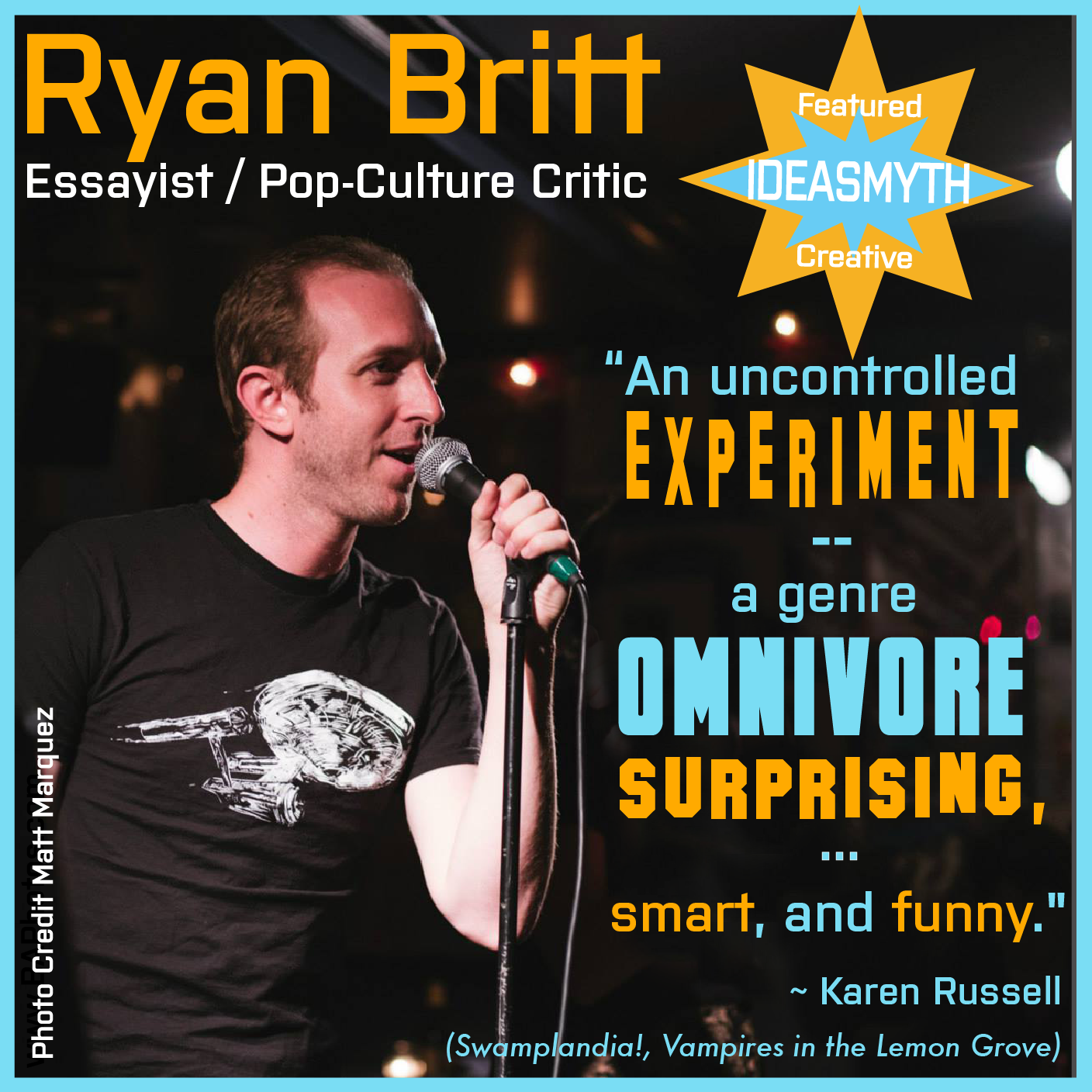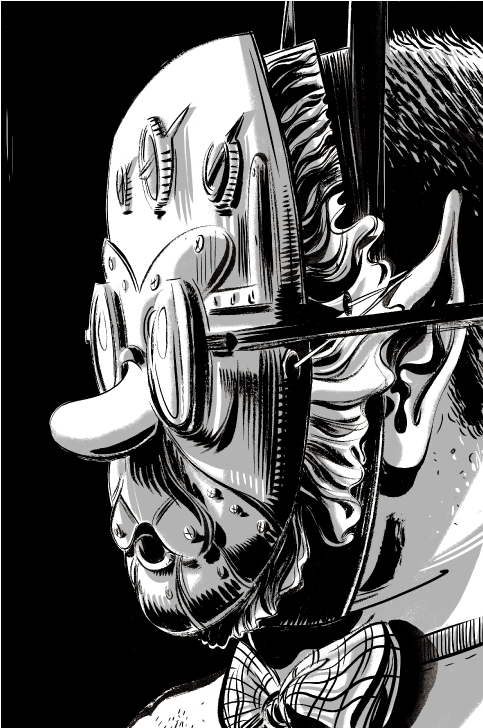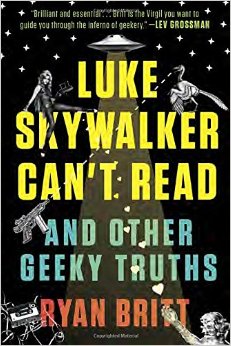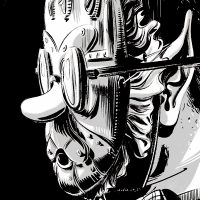Ryan Britt is the Halley’s comet of pop culture critics: a rare bright light not to be missed! His sci-fi criticism embraces a Sedaris-like sense of the absurd that has landed his byline in publications from The New York Times to VICE—and gotten him a book deal (Luke Skywalker Can’t Read: And Other Geeky Truths)—especially impressive for a book industry that typically thumbs its nose to essay collections. This week, he shares some of the geographic and emotional journeys and odd jobs (including “waitress” and “cat-sitter”) that happened along the way to identifying himself as a “Pop-Culture Sci-Fi Guru” (as the back of his book will tell you). We wish we had our own personal TARDIS time machine so we could re-live first encountering his writing multiple times.
is the Halley’s comet of pop culture critics: a rare bright light not to be missed! His sci-fi criticism embraces a Sedaris-like sense of the absurd that has landed his byline in publications from The New York Times to VICE—and gotten him a book deal (Luke Skywalker Can’t Read: And Other Geeky Truths)—especially impressive for a book industry that typically thumbs its nose to essay collections. This week, he shares some of the geographic and emotional journeys and odd jobs (including “waitress” and “cat-sitter”) that happened along the way to identifying himself as a “Pop-Culture Sci-Fi Guru” (as the back of his book will tell you). We wish we had our own personal TARDIS time machine so we could re-live first encountering his writing multiple times.
~The Ideasmyth Team
***

Image credit: Wesley Allsbrook
There’s an essay in my book which begins with a scene on a rooftop of Bushwick, Brooklyn in which a younger version of myself worries about what will happen if two dominatrices push me over the edge. This essay is not about sex or parties or S&M, but it took me awhile to figure that out. Instead, the essay is about robots and it’s called “Hipster Robots Will Save Us All.”
This particular party incident started out as a great anecdote to tell to a group of friends to give them an idea of the types of trouble I was capable of getting up to. The basic story also has some nice twists and turns in terms of revealing how I got on that roof to begin with. But, thematically, other than being shocking and a little risqué, I discovered in the verbal telling of the story that there wasn’t all that much really there. The story wasn’t about anything, instead it was just another crazy tale of a wild night out told by someone who had survived it. Survival is a nice theme for a lot of memoir writing, but surviving something that actually sounds like a humble-brag, well, that’s not really the kind of story I think is one people ever want to return to.
However, when I was working on finalizing the essays that went into the book, I had a big question mark next to a piece called “Trying on the Retro Flesh,” which was an article I’d done for Omni a few years prior about how robots would feel if they ever had to become human again. In that original essay I played with ideas of “authenticity” and whether or not the “authentic” relationship with the human body would be akin to hipsters getting into vinyl records. “Trying on the Retro Flesh,” had a little bit of a memoir component, but not the same amount that I wanted for inclusion into Luke Skywalker Can’t Read. And so, suddenly, the anecdote about the dominatrices and the zany rooftop party had found a home. Instead of only being a fun story, the search for authenticity and the near brush with mortality became a nice framing mechanism for a piece about benevolent artificial intelligence who might take care of all of us some day.

Ryan’s new book–available for purchase here
It might seem counterintuitive and maybe even more than a little bit of a stretch to combine a serious meditation about humanity and artificial life with a crazy “party story,” but what I discovered is that it was truly the only frame that made sense. Sure, I wanted to shock the reader a little bit, to give them a sense of fun and danger, but that’s because the essay was going to go into so many different places of challenging various biases about robots and A.I., that I knew I needed to ground it somewhere else. And sometimes, grounding a piece in an equally absurd story is the best way to make your more intellectually challenging material come across.
Holding on to amazing moments and memories is only part of what makes creative non-fiction good. Your personal journeys and arrivals don’t always turn out to be the Mecca you’re looking for in your writing. Instead, curation of those adventures is where it’s at. Words like “remix” or “mash-up” or “hybrid” have been used a lot–and sometimes by me–to describe this kind of approach to essay writing, and all of it is accurate. Because, ultimately, writing essays is like conducting experiments. But unlike some sort of mad scientist, if the concoction doesn’t work, and it just blows up in your face, the danger is relatively low. The tricky part is having the bravery to know that it’s okay to throw a lot of different ingredients into the mix to begin with.
And then, when you’ve figured that out, having the wisdom to hold onto a few perfect morsels for just the right moment, for just the right essay. Isaac Asimov, the granddaddy of robots once wrote “an essay is an attempt.” It’s not perfect and it might be a little uneven.
But then again, so is your life!
 ~~~Ryan Britt’s writing has appeared in The New York Times, VICE, The Awl, The Morning News, Nerve, Omni, Clarkesworld, The MindHut, The Barnes and Noble Book Blog, Electric Literature, Crossed Genres, The Drum, The Literary Hub and elsewhere. He was formerly the staff writer at the Hugo-Award Winning Web Magazine Tor.com, where he remains a contributor.
~~~Ryan Britt’s writing has appeared in The New York Times, VICE, The Awl, The Morning News, Nerve, Omni, Clarkesworld, The MindHut, The Barnes and Noble Book Blog, Electric Literature, Crossed Genres, The Drum, The Literary Hub and elsewhere. He was formerly the staff writer at the Hugo-Award Winning Web Magazine Tor.com, where he remains a contributor.
Ryan has told stories on stage with The Moth, The Liar Show, RISK! and is the co-curator of two live reading series; Lust for Genre and The Hi-Fi Reading Series. He currently teaches writing for Media Bistro, The Sackett Street Writers’ Workshop, Catapult as well as privately.
Ryan’s first book, the essay collection Luke Skywalker Can’t Read and Other Geeky Truths, will be published by Plume (an imprint of Penguin Random House) on November 24th, 2015.

